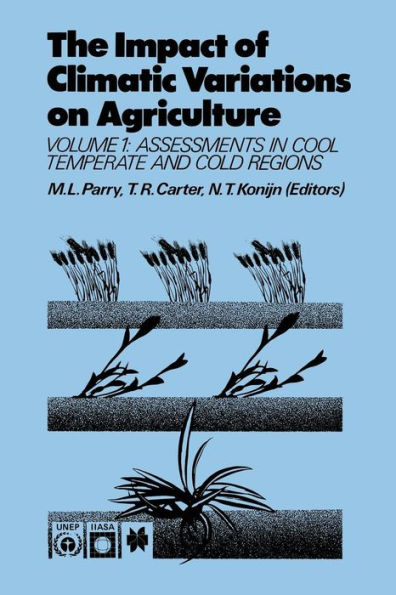5
1

The Impact of Climatic Variations on Agriculture: Volume 1: Assessment in Cool Temperate and Cold Regions
888
by M.L. Parry (Editor), T.R. Carter (Editor), N.T. Konijn (Editor)
M.L. Parry

The Impact of Climatic Variations on Agriculture: Volume 1: Assessment in Cool Temperate and Cold Regions
888
by M.L. Parry (Editor), T.R. Carter (Editor), N.T. Konijn (Editor)
M.L. Parry
Paperback(1988)
$109.99
-
PICK UP IN STORECheck Availability at Nearby Stores
Available within 2 business hours
Related collections and offers
109.99
In Stock
Overview
Three important studies were initiated in the 1970s to investigate the relation ship between climatic variations and agriculture: by the National Delcnse University (1980) on Crop Yields and Climate Change to the Year 2000, by the U.s. Department of Transportation (1975) on Impacts of Climatic Change on the Biosphere and by the U.S. Department of Energy (1980) on Environmental and Societal Consequences of a Possible CO -Induced Climatic Change (the ClAP 2 study). These were pioneering projects in a young field. Their emphasis was on measuring likely impacts of climatic variations rather than on evaluating possible responses, and they focused on first-order impacts (e.g., on crop yields) rather than on higher-order effects on society. A logical next step was to look at higher-order effects and potential responses, as part of a more integrated approach to impact assessment. This was undertaken by the World Climate Impact Program (WCIP), which is directed by the United Nations Environment Program (UNEP). The WCIP is one of four aspects of the World Climate Program that was initiated in 1979. At a meeting in 1982, the Scientific Advisory Committee of WCIP accepted, in broad terms, a proposal from the International Institute for Applied Systems Analysis (IIASA) for an integrated climate impact assessment, with the proviso that the emphasis be on impacts in the agricultural sector. Martin Parry was asked to design and direct the project at IIASA. Funding was provided by UNEP, IIASA, the Austrian Government and the United Nations University.

Product Details
| ISBN-13: | 9789027727015 |
|---|---|
| Publisher: | Springer Netherlands |
| Publication date: | 04/30/1988 |
| Edition description: | 1988 |
| Pages: | 888 |
| Product dimensions: | 6.10(w) x 9.25(h) x 0.07(d) |
Table of Contents
I. The Impact of Climatic Variations on Agriculture: Introduction to the IIASA/UNEP Case Studies.- 1. The assessment of effects of climatic variations on agriculture: aims, methods and summary of results.- 2. The choice of first-order impact models.- 3. Development of climatic scenarios: A. From general circulation models.- 4. Development of climatic scenarios: B. Background to the instrumental record.- 5. A case study of the effects of CO2-induced climatic warming on forest growth and the forest sector: A. Productivity reactions of northern boreal forests.- 6. A case study of the effects of CO2-induced climatic warming on forest growth and the forest sector: B. Economic effects on the world’s forest sector.- II. Estimating Effects of Climatic Change on Agriculture in Saskatchewan, Canada.- 1. Introduction.- 2. The effects on the agroclimatic environment.- 3. The effects on potential for wind erosion of soil.- 4. The effects on spring wheat production.- 5. The effects on the farm and provincial economy.- 6. Conclusions and implications.- III. The Effects of Climatic Variations on Agriculture in Iceland.- 1. Introduction.- 2. The effects on agricultural potential.- 3. The effects on grass yield, and their implications for dairy farming.- 4. The effects on the carrying capacity of rangeland pastures.- 5. Implications for agricultural policy.- IV. The Effects of Climatic Variations on Agriculture in Finland.- 1. Introduction.- 2. The effects on barley yields.- 3. The effects on spring wheat yields.- 4. The effects on the profitability of crop husbandry.- 5. Conclusions and implications for policy.- V. The Effects of Climatic Variations on Agriculture in the Subarctic Zone of the USSR.- 1. Introduction.- 2. The effects on agriculture and environment in the Leningradregion.- 3. The effects on spring wheat yields in the Cherdyn region.- 4. Planned responses in agricultural management under a changing climate.- 5. Results and policy implications.- VI. The Effects of Climatic Variations on Agriculture in Japan.- 1. Introduction: the policy and planning issues.- 2. Development of the climatic scenarios.- 3. The effects on latitudinal shift of plant growth potential.- 4. The effects on altitudinal shift of rice yield and cultivable area in northern Japan.- 5. The effects on rice yields in Hokkaido.- 6. The effects on the Japanese rice market.- 7. The implications for agricultural policies and planning.From the B&N Reads Blog
Page 1 of
